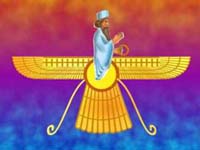Bible | Movies | Books | People | Hot Topics | Holidays | Humor | Gallery | Sanctuary | Sermons | Prayer | Quizzes | Communities | God | FAQ | Links
|
Sponsored Link |
Zoroastrianism arose in Persia (modern Iran) prior to the appearance of Islam. It survives there in isolated areas but most modern day adherents reside in India, where the descendants of Zoroastrian Persian immigrants are known as Parsis, or Parsees. In India the religion is called Parsiism. It was founded by the Iranian prophet and reformer Zoroaster in the 6th century BC, Zoroastrianism contains both monotheistic and dualistic features. Its concepts of one God, judgment, heaven and hell likely influenced the major Western religons of Judaism, Christianity, and Islam. From widely respected reference works: Zoroastrianism. The religion of the followers of the Iranian prophet Zoroaster (c.1200 BCE). The history of the religion prior to the 6th century BCE is largely unknown. Thereafter it became the state religion of three successive Iranian empires: the Achaemenids (c.549-331 BCE); the Parthians (2nd century BCE to 224 CE); and the Sasanians (224-642 CE), the boundaries of whose territories extended into what is now Afghanistan and Pakistan and westwards into what is now Iraq, and at times into Palestine and what is now Turkey. Zoroastrian Iran was finally defeated by the expansion of Islam, but for over 1,000 years Zoroastrianism was the official religion of three major world empires, making it, perhaps, the most powerful world religion of the time. The last Zoroastrian monarch was Yazedegird (d. 652 CE). The modern Zoroastrian calendar begins with his coronation and the designation anno Yazdegird (AY) is used. Since the end of the Zoroastrian state the religion has been persistently and harshly persecuted by Muslims in Iran, so that the faithful few have been forced to retreat into remote villages, especially near the desert cities of Yazd and Kerman, where they have generally lived in abject poverty. Greater freedom was granted under the Pahlavi dynasty, and the new Islamic Republic has promised to preserve the rights of minorities. It is a considerate tribute to the strength of the faith that even a small group has surivived the millennium of oppression. They are often referred to as the 'Zardushti' or as gabr (gaur/gor/guebre), meaning 'infidel'. They themselves sometimes used the term 'Mazda-yasnians' (worshippers of Mazda). In the 10th century CE some Zoroastrians left Iran to seek a new land of religious freedom and settled in north-west India, where they are known as Parsis (=Persians). The main centres of Zoroastrianism nowadays are India (mainly Bombay), 72,000; Iran, 30,000 plus; Pakistan, 2,000; Britain, 5,000; and North America, 6,000 (all figures are approximate). Traditional Zoroastrian teachings are found in the holy book, the Avesta, and the Pahlavi literature. An essential feature of all worship (yasna), centred on fire, is physical and moral purity. Zoroastrianism is often described as a dualism because of its teaching on a wholly good God, Ahura Mazda, who is opposed by the evil Angra Mainyu. It is, however, a central part of this optimistic religion that evil will be defeated. There is no idea of a spirit/flesh dualism because both the spiritual and the material worlds are the creation (bundahishn) of God. Humans therefore have a religious duty to care for both the material and the spiritual aspects of their existence. It is a religion which inculcates the highest moral ideals. Once the believer has been initiated (naujote) he or she (there is little difference in the religious duties of the sexes) should fight evil in all its forms. Zoroastrianism has considerable historical importance because of its geographical position astride the routes between East and West, and also because of its profound influence on Judaism, Christianity, and Islam, especially in regard to beliefs on heaven, hell, resurrection of the dead and the final judgement. It is also thought that it inspired a belief in a saviour to come in Hinduism (Kalkin) and Buddhism. From John R. Hinnels, ed., The Penguin Dictionary of Religions, 2nd ed. (1997). Text © Penguin Books.
Zoroastrianism and Parsiism. Ancient religion that originated in Iran based on the teachings of Zoroaster. Founded in the 6th century BCE, it influenced the monotheistic religions Judaism, Christianity, and Islam. It rejects polytheism, accepting only one supreme God, Ahura Mazda. In early Zoroastrianism, the struggle between good and evil was seen as an eternal rivalry between Ahura Mazda's twin sons, Spenta Mainyu (good) and Angra Mainyu (evil). Later Zoroastrian cosmology made the rivalry between Ahura Mazda himself (by then called Ormizd) and Angra Mainyu (Ahriman). This later cosmology identifies four periods of history; the last began with the birth of Zoroaster. Zoroastrian practice includes an initiation ceremony and various rituals of purification intended to ward off evil spirits. Fire worship, a carryover from an earlier religion, survives in the sacred fire that must be kept burning continually and be fed at least five times a day. The chief ceremony involves a sacrifice of haoma, a sacred liquor, accompanied by recitation of large parts of the Avesta, the primary scripture. Zoroastrianism enjoyed status as an official religion at various times before the advent of Islam, but Zoroastrians were persecuted in the 8th–10th centuries, and some left Iran to settle in India. By the 19th century these Indian Zoroastrians, or Parsis, were noted for their wealth and education. The small group of Zoroastrians remaining in Iran are known as the Gabars. From Wendy Doniger, ed., Merriam-Webster's Encyclopedia of World Religions Websites on or about Zoroastrianism Ontario Consultants on Religious Tolerance - Zoroastrianism Avesta - Zoroastrian Archives Avesta - Frequently Asked Questions Avesta - Glossary Zoroastrianism - by Hannah M.G. Shapero Vispi Bulsara's Zoroastrian Web Page Why interfaith understanding, dialogue and cooperation are important Can
Christians Alone Be Saved?
Please take a moment to let us know you
were here!
If you want to talk with someone in person, please feel free to call 917-439-2305
The Rev. Charles P. Henderson is a Presbyterian minister and is the author of God and Science (John Knox Press, 1986). Charles also tracks the boundry between the virtual and the real at his blog: Next World Design, focusing on the mediation of art, science and spirituality in the metaverse. For more information about Charles Henderson. |
Sponsored Link
|
|||||

 With a membership of about 140,000, the importance of Zoroastrianism is far greater than its numbers suggest, for several reasons. First, it has influenced Judaism, Christianity, Islam and other world religions. Second, it is one of the oldest living religions. Finally, some argue is was the first monotheistic religion; others claim this for Judaism.
With a membership of about 140,000, the importance of Zoroastrianism is far greater than its numbers suggest, for several reasons. First, it has influenced Judaism, Christianity, Islam and other world religions. Second, it is one of the oldest living religions. Finally, some argue is was the first monotheistic religion; others claim this for Judaism. 